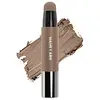Westman Atelier Face Trace Cream Contour Stick Versus Haus Labs By Lady Gaga Precision Sculpt Shaping Balm Contour Stick
What's inside
What's inside
 Key Ingredients
Key Ingredients

 Benefits
Benefits

 Concerns
Concerns

 Ingredients Side-by-side
Ingredients Side-by-side

Caprylic/Capric Triglyceride
MaskingKaolin
AbrasiveCaprylyl Caprylate/Caprate
EmollientSimmondsia Chinensis Seed Oil
EmollientPolyethylene
AbrasiveMica
Cosmetic ColorantPolyhydroxystearic Acid
EmulsifyingLecithin
EmollientBehenylcarbamoylpropyl Polysilsesquioxane
Tocopherol
AntioxidantAscorbyl Palmitate
AntioxidantCitric Acid
BufferingRubus Idaeus Leaf Cell Culture
Skin ConditioningTitanium Dioxide
Cosmetic ColorantCI 77891
Cosmetic ColorantIron Oxides
CI 77491
Cosmetic ColorantCI 77492
Cosmetic ColorantCI 77499
Cosmetic ColorantCI 73360
Cosmetic ColorantBlue 1 Lake
Cosmetic ColorantCI 42090
Cosmetic ColorantCI 15850
Cosmetic ColorantCI 19140
Cosmetic ColorantCaprylic/Capric Triglyceride, Kaolin, Caprylyl Caprylate/Caprate, Simmondsia Chinensis Seed Oil, Polyethylene, Mica, Polyhydroxystearic Acid, Lecithin, Behenylcarbamoylpropyl Polysilsesquioxane, Tocopherol, Ascorbyl Palmitate, Citric Acid, Rubus Idaeus Leaf Cell Culture, Titanium Dioxide, CI 77891, Iron Oxides, CI 77491, CI 77492, CI 77499, CI 73360, Blue 1 Lake, CI 42090, CI 15850, CI 19140
Dimethicone
EmollientSynthetic Wax
AbrasiveSilica
AbrasivePolyglyceryl-2 Triisostearate
EmulsifyingCaprylyl Methicone
Skin ConditioningDiisostearyl Malate
EmollientCaprylic/Capric Triglyceride
MaskingTrimethylsiloxysilicate
EmollientDimethicone/Vinyl Dimethicone Crosspolymer
Skin ConditioningRicinus Communis Seed Oil
MaskingZea Mays Oil
EmulsifyingVitis Vinifera Fruit Extract
Skin ConditioningRosa Hybrid Flower Extract
Skin ConditioningQuercus Suber Bark Extract
Skin ConditioningSqualane
EmollientArnica Montana Flower Extract
MaskingAngelica Gigas Root Extract
Skin ConditioningPseudozyma Epicola/Lithospermum Erythrorhizon Root Extract Ferment Filtrate Extract
EmollientPseudozyma Epicola/Avocado Oil Ferment Extract
EmollientPrunus Armeniaca Kernel Oil
MaskingOlea Europaea Fruit Oil
MaskingPrunus Amygdalus Dulcis Oil
Skin ConditioningHelianthus Annuus Seed Oil
EmollientGlycyrrhiza Glabra Root/Sucrose Ferment Extract Filtrate
AntioxidantPseudozyma Epicola/Camellia Sinensis Seed Oil Ferment Extract Filtrate
HumectantPseudozyma Epicola/Sunflower Seed Oil Ferment Extract Filtrate
Emulsion StabilisingPolyglyceryl-3 Diisostearate
EmulsifyingPolyglyceryl-3 Polyricinoleate
EmulsifyingStearalkonium Bentonite
Gel FormingCalcium Sodium Borosilicate
Triethoxycaprylylsilane
Boron Nitride
AbsorbentKaolin
AbrasiveAluminum Hydroxide
EmollientPentaerythrityl Tetra-Di-T-Butyl Hydroxyhydrocinnamate
AntioxidantDicalcium Phosphate
AbrasiveCetearyl Dimethicone/Vinyl Dimethicone Crosspolymer
EmollientPolyhydroxystearic Acid
EmulsifyingCI 77891
Cosmetic ColorantCI 77491
Cosmetic ColorantCI 77492
Cosmetic ColorantCI 77007
Cosmetic ColorantDimethicone, Synthetic Wax, Silica, Polyglyceryl-2 Triisostearate, Caprylyl Methicone, Diisostearyl Malate, Caprylic/Capric Triglyceride, Trimethylsiloxysilicate, Dimethicone/Vinyl Dimethicone Crosspolymer, Ricinus Communis Seed Oil, Zea Mays Oil, Vitis Vinifera Fruit Extract, Rosa Hybrid Flower Extract, Quercus Suber Bark Extract, Squalane, Arnica Montana Flower Extract, Angelica Gigas Root Extract, Pseudozyma Epicola/Lithospermum Erythrorhizon Root Extract Ferment Filtrate Extract, Pseudozyma Epicola/Avocado Oil Ferment Extract, Prunus Armeniaca Kernel Oil, Olea Europaea Fruit Oil, Prunus Amygdalus Dulcis Oil, Helianthus Annuus Seed Oil, Glycyrrhiza Glabra Root/Sucrose Ferment Extract Filtrate, Pseudozyma Epicola/Camellia Sinensis Seed Oil Ferment Extract Filtrate, Pseudozyma Epicola/Sunflower Seed Oil Ferment Extract Filtrate, Polyglyceryl-3 Diisostearate, Polyglyceryl-3 Polyricinoleate, Stearalkonium Bentonite, Calcium Sodium Borosilicate, Triethoxycaprylylsilane, Boron Nitride, Kaolin, Aluminum Hydroxide, Pentaerythrityl Tetra-Di-T-Butyl Hydroxyhydrocinnamate, Dicalcium Phosphate, Cetearyl Dimethicone/Vinyl Dimethicone Crosspolymer, Polyhydroxystearic Acid, CI 77891, CI 77491, CI 77492, CI 77007
 Reviews
Reviews

Ingredients Explained
These ingredients are found in both products.
Ingredients higher up in an ingredient list are typically present in a larger amount.
This ingredient is an emollient, solvent, and texture enhancer. It is considered a skin-softener by helping the skin prevent moisture loss.
It helps thicken a product's formula and makes it easier to spread by dissolving clumping compounds.
Caprylic Triglyceride is made by combining glycerin with coconut oil, forming a clear liquid.
While there is an assumption Caprylic Triglyceride can clog pores due to it being derived from coconut oil, there is no research supporting this.
Learn more about Caprylic/Capric TriglycerideCi 77491 is also hydrated iron III oxide. It's sole purpose is to give a red/pink hue to products.
Iron III oxides are classified as inorganic chemicals for coloring.
Synthetically created Ci 77491 is considered safer than those naturally found. This is because the synthetically created version may contain less impurities. Iron oxides are generally non-toxic and non-allergenic.
Learn more about CI 77491Ci 77492 is also hydrated iron III oxide. It's sole purpose is to give a yellow hue to products.
Iron III oxides are classified as inorganic chemicals for coloring.
Synthetically created Ci 77492 is considered safer than those naturally found. This is because the synthetically created version may contain less impurities. Iron oxides are generally non-toxic and non-allergenic.
Learn more about CI 77492Ci 77891 is a white pigment from Titanium dioxide. It is naturally found in minerals such as rutile and ilmenite.
It's main function is to add a white color to cosmetics. It can also be mixed with other colors to create different shades.
Ci 77891 is commonly found in sunscreens due to its ability to block UV rays.
Learn more about CI 77891Kaolin is a clay. It is used for oil control and to help minimize pores. Like other clays, kaolin has the ability to absorb excess sebum or oil. This can help clean out pores and mattify the skin.
Some types of kaolin may have exfoliating properties. When water is added to kaolin, it becomes a paste with small abrasive particles.
Most kaolin is a white color, but may be pink/orange/red depending on where it comes from.
The name 'kaolin' comes from a Chinese village named 'Gaoling'. Kaolin clay comes from rocks rich in kaolinite. Kaolinite, the mineral, has a silicate layered structure. Kaolinite is formed from chemical weathering of aluminum siilicate minerals.
Besides skincare, kaolin is commonly used to make glossy paper, in ceramics, toothpaste, and as medicine to soothe stomach issues.
Learn more about KaolinPolyhydroxystearic Acid is a soft wax made from castor oil.
It is is a texture thickener, emulsifier, and film-former. Emulsifiers prevent ingredients from separating, such as oils and waters.
Polyhydroxystearic Acid may not be fungal acne safe.
Learn more about Polyhydroxystearic Acid